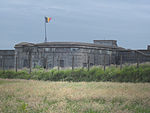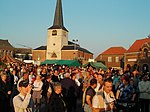Brussels–Scheldt Maritime Canal
1561 establishments in the Holy Roman EmpireCanals in Antwerp ProvinceCanals in BrusselsCanals in FlandersCanals in Flemish Brabant ... and 3 more
Canals opened in 1561Olympic rowing venuesVenues of the 1920 Summer Olympics

The Brussels–Scheldt Maritime Canal (commonly named in various ways including Willebroek Canal and Brussels-Willebroek canal), is a canal in Belgium linking Brussels with the Scheldt river and ultimately the sea. The 28 km long canal has a width of 30 m. and a draught of 2 m., and connects the cities of Brussels and Willebroek, where it joins the Rupel river in the hamlet of Klein-Willebroek. Hence previously the canal was officially known as the Brussels-Rupel Maritime Canal prior to the establishment of a direct link with the Scheldt in 1997. The canal is one of the oldest navigable canals in Belgium and indeed in Europe.
Excerpt from the Wikipedia article Brussels–Scheldt Maritime Canal (License: CC BY-SA 3.0, Authors, Images).Brussels–Scheldt Maritime Canal
Westdijk,
Geographical coordinates (GPS) Address Nearby Places Show on map
Geographical coordinates (GPS)
| Latitude | Longitude |
|---|---|
| N 51.028 ° | E 4.357 ° |
Address
Westdijk
Westdijk
2830
Antwerp, Belgium
Open on Google Maps









